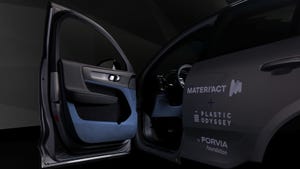Recreating the feel of high-grade semi-aniline leather using synthetic leather is somewhat of a holy grail for auto interior designers. Nissan Motor (Tokyo) believes it has gone some way towards achieving this objective with its Sofilez skin material used in the Nissan Fairlady 370Z which debuted in 2009.
June 20, 2011
Recreating the feel of high-grade semi-aniline leather using synthetic leather is somewhat of a holy grail for auto interior designers. Nissan Motor (Tokyo) believes it has gone some way towards achieving this objective with its Sofilez skin material used in the Nissan Fairlady 370Z which debuted in 2009.
Protein and plastic make for genuine leather feel in auto interior (circled in blue; genuine leather circled in green). |
In a presentation at the Asia Petrochemical Industry Conference (APIC) in May in Fukuoka, Japan, Manabu Tachibana, deputy general manager of the powertrain materials group at Nissan went into unprecedented detail about how they identified they key attributes desired by consumers in automobile upholstery and developed a material to reproduce these. Firstly, parent company Renault surveyed 360 respondents in six countries regarding their preferred touch feelings and found that there was a significant gap between the positive perception regarding genuine leathers used in apparel and furniture and the relatively mediocre perception of synthetic leathers used in automobile interiors. "We needed to develop a material that matched the positive sensation of apparel and furniture leather," said Tachibana.
Nissan identified the factors involved in tactile sensation as being warm-cold (heat conductivity), soft-hard (deformation volume), smooth-coarse (surface roughness) and wet-dry (friction) and developed a predictive formula based on these parameters to define touch sensation called the Customer Preference Index. The index for a particular material is calculated from softness, wetness, roughness and warmness based on physical properties and the same material is then rated based on sensory evaluation. This allowed Nissan to correlate physical properties with perceptions in the real world. "We found that people are most comfortable with a softness close to the finger's softness and surface asperity close to the finger print," noted Tachibana.
Nissan teamed up with material supplier Idemitsu Technofine (Tokyo) and processor Komatsu Seiren (Nomi, Japan) to develop a skin material delivering these attributes. The end result is Sofilez, a synthetic leather made from a specialty resin believed to be polyurethane-based blended with a protein powder based on egg shells. It incorporates a thin protective coating with high strength and good elongation, balancing soft touch with durability.-[email protected]
You May Also Like


